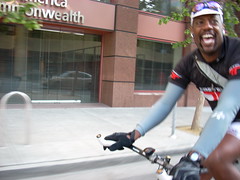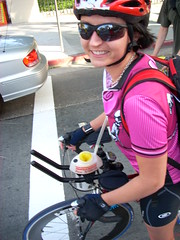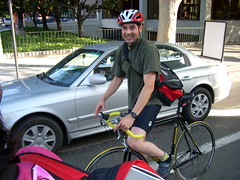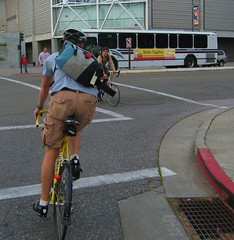San Jose, California Leaders Call for Bold Bicycle Program in the Downtown. Pilot program to link downtown employers, San Jose State University, Guadalupe River Corridor and transit hubs.
Without a pesky court order to slow the implementation of a bike plan, San Jose Mayor Chuck Reed with Councilmembers Sam Liccardo and Forrest Williams call for a downtown bicycle demonstration project to increase bicycle trips and radically alter the downtown streetscape.
The proposal aims to increase bicycle usage among commuters by changin street elements in three significant ways: Physically separated bike lanes along key downtown commute corridors; better bike parking including public bike racks and “bike valets” at major festivals, concerts, or sporting events; and the introduction of a “bike share” or similar bicycle rental program.
“Every day our residents have opportunities to help implement San Jose’s Green Vision and save carbon emissions. I hope that this project will make it easier for residents to choose to commute to work or school by bike,” says Mayor Reed. “Every commuter who bikes rather than drives saves five pounds of carbon emissions over a five-mile trip.”
San Jose, California has 140 miles of bike lanes, 40 miles of bike trails, and 16 miles of bike routes, yet residents commute to work by bike less than 1% of the time, a rate well behind nearby towns such as Palo Alto and Mountain View, and far behind national leader Portland (3.5%). Surveys show that many people are reluctant about riding to work because they don’t feel safe.
“We have much work to do to enable more people to feel safe taking their bike to work,” Councilmember Liccardo noted, “and this initiative focuses on creating that safe environment.”
“Safety should be a top priority for any program. This proposal puts safety first with the implementation of physically segregated lanes,” added Councilmember Williams.
Improving cyclists’ sense of safety will be achieved through creation of physically segregated lanes along two or more key corridors, according to spokeswoman Michelle McGurk. A physical barrier — such as trees, shrubbery, or a simple curb — separates the bicycle lane from traffic.
In San Jose, the pilot program would focus on linking San Jose State University and other major employers and downtown destinations with transit hubs at Diridon station and the Transit Mall, and along the Guadalupe River Park corridor.
Another disincentive to cycling arises from the quandary many commuters face about where to leave their bike when they get to a transit stop or their final destination. Some feel reluctant to leave their own bikes at public racks for lengthy periods, due to concerns about theft and damage. More often, cyclists cannot find space to board their bikes on Caltrain, Light Rail, and buses. In a 2007 survey, 42% of cyclists reported having experienced an inability to board Caltrain five times or more in the past year because the “bicycle car” was full.
Accordingly, the initiative focuses on expanding its inventory of over 500 public bike racks, particularly at key destinations. The proposal also urges city staff to explore the concept of contracting with private parties to provide “bike valet” services at Diridon Station and at downtown events.
Finally, the initiative introduces a “bike share” program of short-term rental of bicycles from “docking stations” with the use of a credit card or pre-programmed membership card. These privately-funded programs have taken hold in many cities throughout Europe, and have significantly increased bike commuting. By locating “bike share” stations at key Caltrain and Light Rail transit stops, the program enables people to rely on biking to transit without concerns about whether there will be sufficient room on board for their bike.
The initiative focuses on the downtown area because of its high density of transit, its close proximity of major employers, and because of its visibility to visitors, where a vibrant program can “sell” San Jose’s high quality of life and extraordinary climate.






